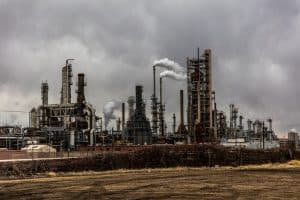Simply put, the decoking process is a procedure for cleaning the tubing and piping of fired furnaces in oil refineries, chemical plants, and other energy supply factories to ensure efficiency, sustainability, and equipment longevity. This process removes the buildup of waste from the production of coke, a fuel made from heating coal without air, and other residues from the tubes.
The Pig Method

Many different methods have been used to decoke assets such as furnaces and vessels. These methods including sandblasting, hydroblasting, radiant coils, steam-air decoking, and turbining (which is also used in the control of compressors and generators). However, the pig method is the most popular decoking process in practice today because it can safely and effectively remove coke deposits.
Step One: Prepare the Pipes
Feedstock is a raw product that is transferred through the furnace lines before being transformed into other products or the final product. Before the decoking process can begin, tubing and pipes must be cleaned using steam to rid them of any remaining feedstock, leaving behind only coke residue.
Step Two: Consider the Pigs
The piping is examined to determine its thickness and metallurgical properties. This information is considered when deciding which size and types of pigs to use, as well as the number of pigs that will be needed. Different kinds of pigs are used for different processes; and they vary in shape, size, hardness, and function. The pigs used in decoking fired heaters are called hard-claw or decoking pigs. They remove hard carbon and iron sulfide from furnaces. Other uses include removing calcium scale and cement slurry from pipelines as well as rust and sludge in municipal, industrial, and seawater lines. Each pig has pins that are arranged evenly around its surface, allowing it to scrape off residue without the use of high heat, which can cause corrosion or weaken the integrity of the pipes.
Step Three: Insert the Pigs
Once the pipes are ready and the correct types of pigs have been determined, the next step is to insert the pigs into the furnace tubing. This is done with the use of launchers, which are attached to both the inlet and outlet pipes of the furnace. Once placing is determined, the pigs are forced into the system using air.
Step Four: Push the Pigs Through
Then, using a closed loop system, pressurized water sends the pigs through the furnace tubing and back to the loading point several times to effectively descale the insides of the pipes. Once the debris is completely removed, the pipes are rinsed, and the job is finished.
The pig method efficiently removes coke residue from furnace tubing and maintains the longevity of pipes by using non-damaging materials in an environmentally friendly manner. The volume of water used in the pig method is strictly controlled and is less than conventional methods. Once the buildup inside of the pipes is removed, it flows into a collection tank. In addition to its other benefits, the pig method is approximately five times faster than traditional decoking methods, and there’s no need to disassemble and reassemble piping or use supplementary valves for the pigs.
Custom Decoking Solutions
While the decoking process can be completed in several different ways, the pig method is the optimal choice for cleaning fired heaters. It’s a streamlined process that’s ecologically superior to older methods, effective in the removal of buildup and waste, and gentle on pipes. This process can be easily managed with Petrotech’s decoking control systems, which can be retrofitted for compatibility with existing equipment to maintain productivity. To learn more about how Petrotech can create and install a specialized turnkey system for your facility’s current installations, request a quote today.
